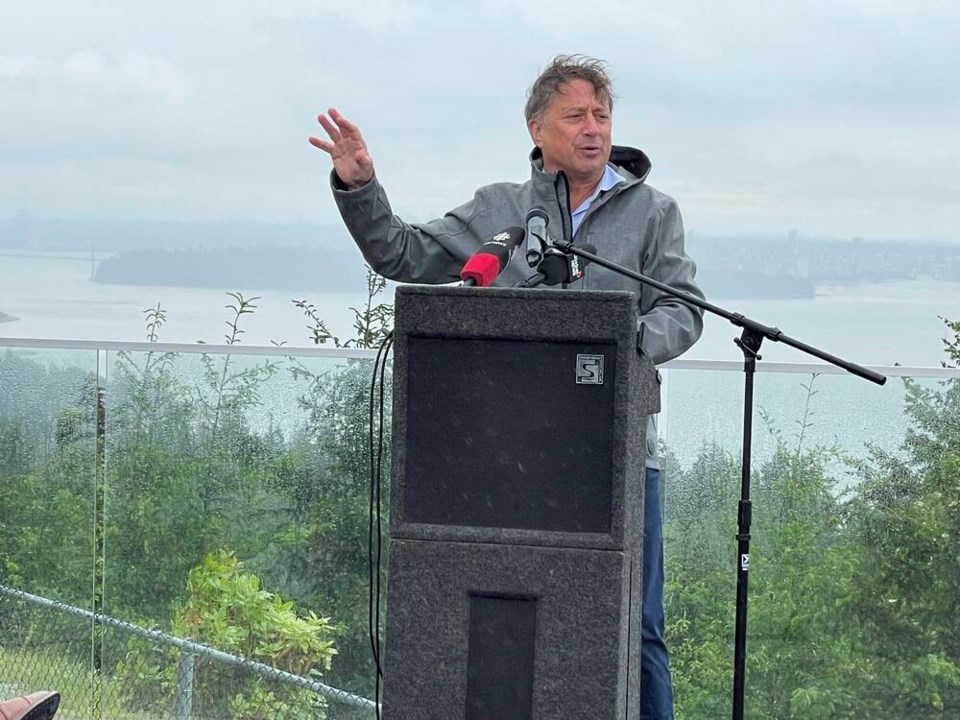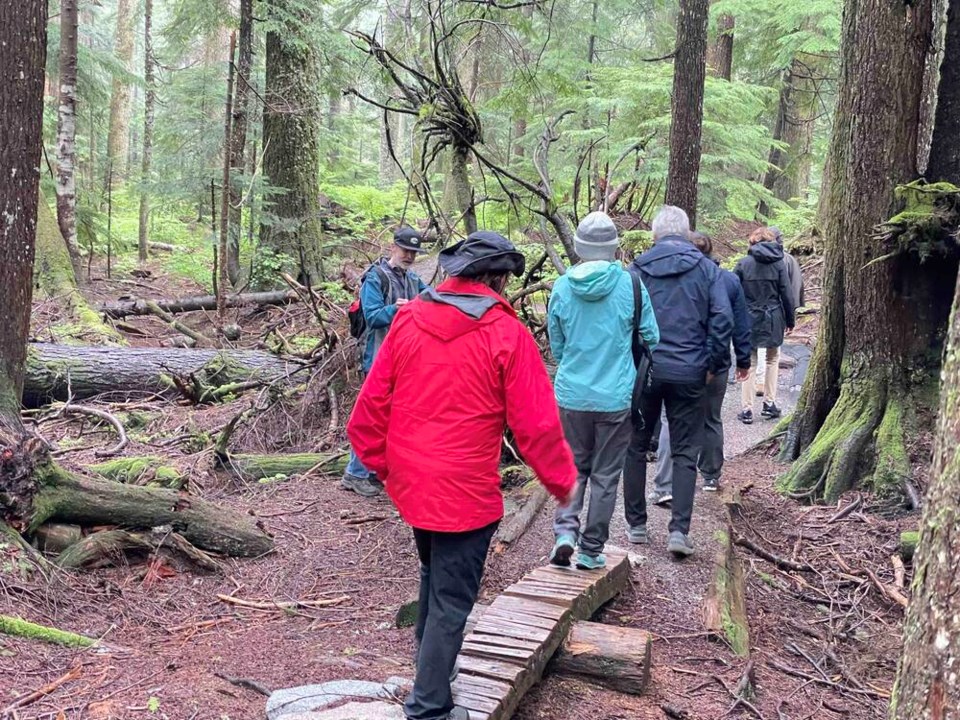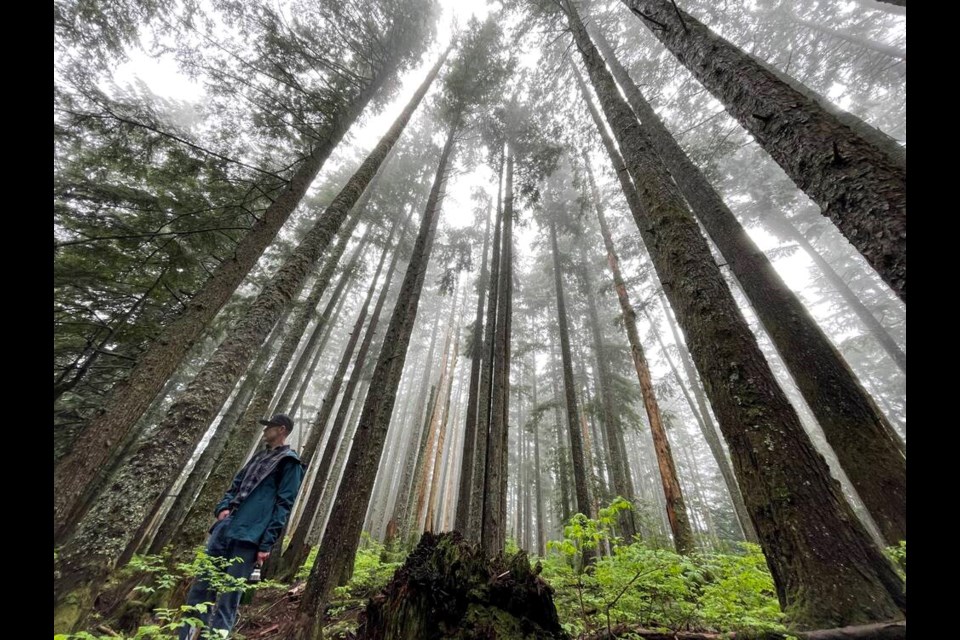High in the forest perched above West Vancouver, the mist drips down around the sword ferns on the spongy ground, beneath towering hemlock trees stretching far, far up to the light.
“Big trees tend to create their own climate,” said Alan Bardsley, president of the Old Growth Conservancy Society that has stewarded this special area in West Vancouver for the past 15 years. “In summer you can come here and see there’s still water dripping through.”
Skunk cabbage unfurls in a pool near the trail.
Bardsley points to muscular lines of reddish bark running up the side of one huge tree. Those outer layers of bark are keeping the tree alive, he says, although the core has long since died.
Near the entrance to the trail, a barred owl sits quietly observing high in the canopy, its head swiveling once, twice before it takes flight, gliding through the treetops on massive wings.
Areas like this in the West Vancouver forest have greater protection this week after the District of West Vancouver voted to formally dedicate 1,932 acres of district-owned land above the Upper Levels highway as park.
The area is currently mostly made up of undeveloped forest land and hiking trails at higher elevations above the British Properties, between the municipality’s Eagle Lake watershed in the west and Metro Vancouver’s Capilano watershed in the east.
District of West Vancouver Mayor Mark Sager and B.C. Parks Foundation CEO Andrew Day made the announcement Monday morning, at the Cypress Village pop-up overlooking Burrard Inlet and Metro Vancouver.
“We’re sending a message to everybody that we care about the environment, we care about the backdrop to our city,” Sager said.

One of largest protected areas near urban centre
The new park is almost twice the size of Stanley Park. Combined with other existing nearby municipal and provincial parks on the North Shore, “this area is one of the largest protected areas within an hour of an urban centre in the world,” said Day.
Monday’s park dedication more than doubles the amount of park land in West Vancouver, according to district staff. Parks now represent 11 per cent of all district-controlled land.
Plans to preserve the area for both recreation and as a critical environmental reserve for the Lower Mainland have long been under discussion and has been recommended by previous municipal task forces that investigated the issue.
But the area has never formally been dedicated as a park.
Sager said some of the park area will be conserved for wildlife and ecological values while other parts will be accessible to the public.
Coun. Sharon Thompson, who introduced the parks bylaw along with Coun. Peter Lambur, said creating the park is important for “protecting our quality of life” on the North Shore and making sure the area is saved for future generations.
B.C. Parks Foundation launches fund
In concert with the new park dedication, on Monday the B.C. Parks Foundation also launched a Cypress Hollyburn Foundation with money going towards projects in the new park. Those could range from wildfire education to construction and upkeep of trails and bridges and creation of spaces for people with disabilities, said Day. A $3 million grant from the Wilson 5 Foundation will match funds for any donation to kickstart the new fund.
Day, the son of former West Vancouver councillor Rod Day, said creation of the park has particular meaning to him.
“When I was younger, I walked all through these hills, and I had my first experience in an old growth forest,” he said. "The trees were bigger, the ground was softer. The air had a beautiful temperature, and the light was just gorgeous.
“But there was something else that I felt at that time. And that was this sense that this place had a kind of sentience and intelligence of its own. And I remember thinking, ‘Are we intelligent enough as human beings to understand the intelligence of nature?’ And over the course of my lifetime, what I’ve seen is that we are awakening to the intelligence of nature, we’re realizing that nature is far smarter than we are at regulating climate, at pulling carbon out of the atmosphere, at regulating water flow and producing clean water. It’s also incredibly intelligent at producing health for us and other species.”
The history of efforts to preserve forest land in West Vancouver’s upper lands dates back almost 35 years.
In the spring of 1990, West Vancouver council was just a couple votes away from clear-cutting up to 140-hectares of municipally owned land on Hollyburn Mountain and leasing it out to a developer who would turn it into a 27-hole golf course. But a group of activists stepped in and forced a referendum. The public turned the golf course down. That area later became the Old Growth Conservancy.

Some veteran trees protected
Most of the forest land protected Monday is second-growth forest, originally logged about 100 years ago.
But within that second-growth forest there are also much-older veteran trees as well.
“Some of those trees are 200, 400 or 800 years old, “said Bardsley, who helped complete a volunteer study of some of those trees along with David Cook, and who was part of the original group determined to save the forest in West Vancouver.
Sager said Monday he was grateful for all of the people who have worked on protection of the area over the years.



